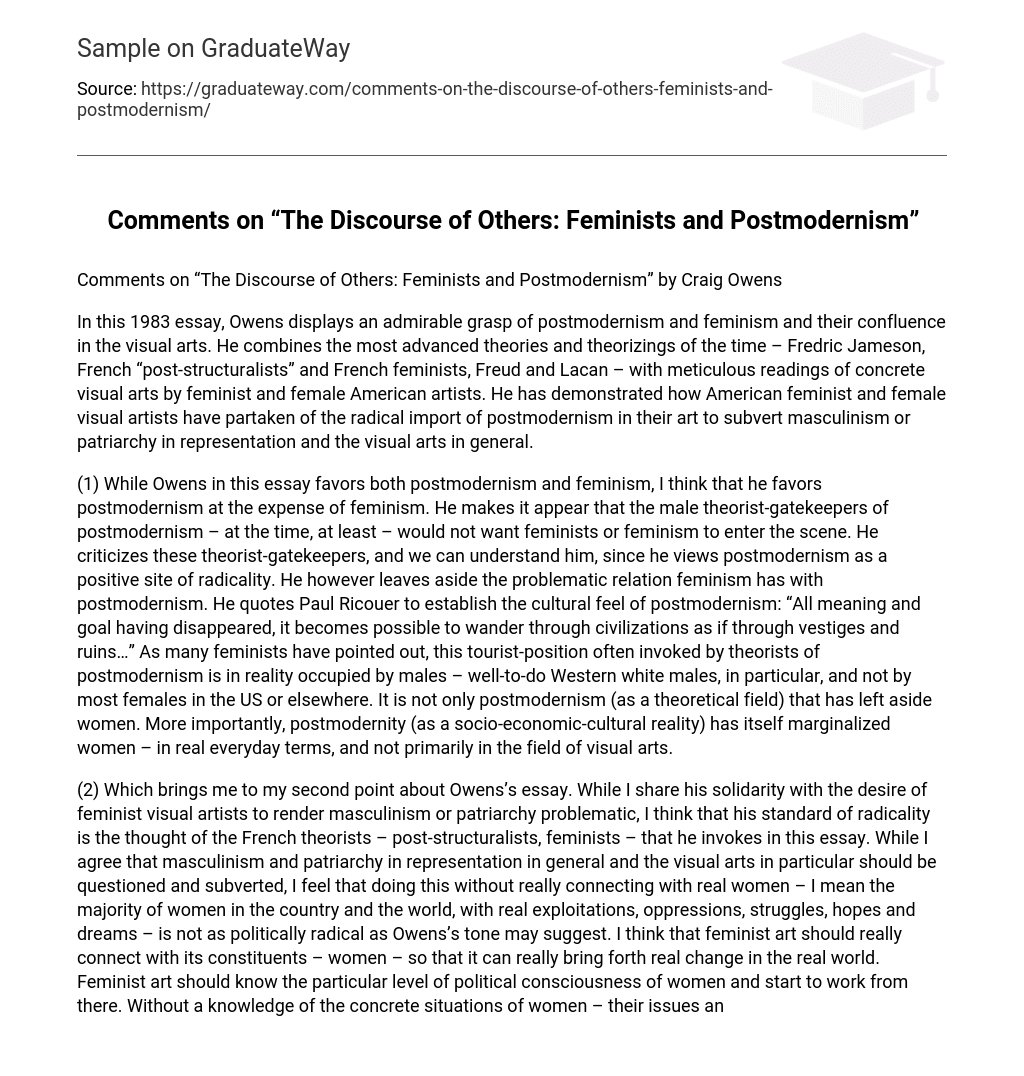Comments on The Discourse of Others: Feminists and Postmodernism” by Craig Owens.
In this 1983 essay, Owens demonstrates an admirable grasp of postmodernism and feminism and their confluence in the visual arts. He combines advanced theories from Fredric Jameson, French post-structuralists,” and French feminists with meticulous readings of concrete visual arts by feminist and female American artists. Owens shows how American feminist and female visual artists have used the radical import of postmodernism to subvert masculinism or patriarchy in representation and the visual arts in general.
While Owens favors both postmodernism and feminism in this essay, it appears that he favors postmodernism over feminism. He criticizes the male theorist-gatekeepers of postmodernism, suggesting they did not want feminists or feminism to enter the scene. This criticism is understandable since he views postmodernism as a positive site of radicality. However, Owens leaves aside the problematic relationship between feminism and postmodernism.
Owens quotes Paul Ricouer to establish the cultural feel of postmodernism: “All meaning and goal having disappeared, it becomes possible to wander through civilizations as if through vestiges and ruins…” However, many feminists have pointed out that this tourist-position often invoked by theorists of postmodernism is occupied by males – well-to-do Western white males in particular – and not by most females in the US or elsewhere.
It is important to note that it is not only theoretical fields like postmodernism that have left women aside. More importantly, socio-economic-cultural realities like postmodernity itself have marginalized women in real everyday terms rather than just within visual arts.
(2) This brings me to my second point about Owens’s essay. While I share his solidarity with feminist visual artists’ desire to render masculinism or patriarchy problematic, I believe that his standard of radicality is based on the thought of French theorists – post-structuralists, feminists – that he invokes in this essay. Although I agree that questioning and subverting masculinism and patriarchy in representation, in general, and the visual arts, in particular, is essential; doing so without connecting with real women – the majority of women worldwide who face exploitations, oppressions, struggles as well as hopes and dreams – is not politically radical as Owens’s tone may suggest.
I think feminist art should genuinely connect with its constituents – women – so it can bring forth real change in the world. It should understand their issues and political consciousness levels to work from there. Without knowledge of concrete situations faced by women or their aspirations, postmodern feminist art will only cater to an elite group of artists and critics endlessly debating how best to subvert signifiers or representations.
This idea comes from Jameson – whom Owens criticizes in this essay. Is it politically good to subvert representation when depicting wife-beating?
(3) Terry Eagleton, whose name does not appear in Owens’s essay, has stated that postmodernism is a result of political failure – specifically, the Left’s failure which includes feminism. When unable to attack and destroy masculinism or patriarchy in the real world, one can always subvert them in visual arts. Postmodernism became a substitute for actual political struggles according to him. Many feminist critics view the 80s as a decade of conservatism – a decade of greed,” as writer Barbara Ehrenreich describes it. I believe that Owens’s essay is indicative of the general mood during that decade; one different from the radical 60s. While I do appreciate feminist or women artists such as Laurie Anderson, Mary Kelly, and Martha Rosler whose works he discusses, I think their “subversion” is too academic for most women in the country to appreciate fully. Without this appreciation, feminism marginalizes itself by becoming just one among many discourses available solely to an elite coterie of artists and critics. In my opinion, feminism should break out of this pigeonhole and reach wider audiences among women so it can become relevant to their lives.
(4) Some theorists have described postmodernism as the cultural logic” not only of “late capitalism,” but also of American global hegemony. We are referring to the America of the late 70s and 80s, when progressive movements, including feminism, were in retreat. Jameson dates the start of postmodernism to 1972. Owens’s essay is a symptom of that retreat, and I doubt whether the postmodern-feminist visual arts he champions in this essay will be politically relevant under current circumstances in the country.





